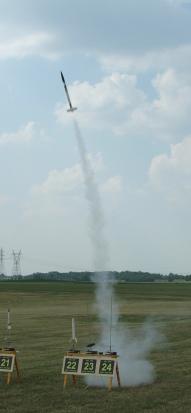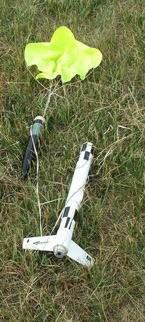| Construction Rating: | starstarstarstarstar |
| Flight Rating: | starstarstarstarstar |
| Overall Rating: | starstarstarstarstar |
| Manufacturer: | Estes  |
 Brief:
Brief:
The Maxi-Icarus was produced from 1980 to 1984, a period when rocketry was about the furthest thing from my mind but
I had always like the looks of the Icarus. I never really set out to clone this bird. It came about when I was looking
over the nose cone
list trying to find a project for a PNC-60AH from my last Screamin' Mimi kit. Realizing that I also had an extra
PST-60R laying around made the project a no-brainer.
Construction:
Parts included:
- PNC-60AH nose cone (scavenged from a Screamin' Mimi kit)
- PST-60R payload tube (scavenged from a Loadstar kit)
- NB-60 nose block (Semroc)
- BT-60 body tube
- BT-50J engine tube
- EH-2 engine hook
- TA-71 centering rings
- AR-2050 engine block
- 2 LL-2AM launch lugs
- large screw eye
- 48" sewing elastic shock cord
- 48" Kevlar® shock cord
- 3/32" fin stock
- large snap swivel
- 18" parachute
I gave some thought to building the engine mount with an E hook, but went with the standard 18-24mm hook instead. This was a mistake. For some reason I decided that building it stock would be better but had I built it with the E mount I could have swapped in the shorter D's and C's with a spacer.

 Finishing:
Finishing:
Tube spirals and balsa grain were killed off with an initial coat of primer followed by two coats of thinned Elmer's
Fill & Finish®
and a second coat of primer, sanding between each coat. The paint is a simple black and white scheme. All paints were
Valspar and decals were supplied as a favor by Scott Branche.
Construction Rating: 5 out of 5
Flight:
The unpainted first flight of the Maxi-Icarus took place on a windy day at a QUARK launch in the spring of 2007. With
the steady breeze, I decided to go with a C11-5 for the first flight. It proved to be plenty of motor for the
conditions. Windcocking was fairly severe off the pad but the flight was plenty stable. The five second ejection was a
perfect choice (lucky) and fired just as the rocket began to tip over. The same winds that caused the windcocking then
brought the rocket back toward the pad and it recovered within 100' of the pad.
Finally painted and decaled, the second flight took place at the 2007 National Sport Launch in Muncie, Indiana. Scott McCrate had mentioned numerous times over the years about how impressive the field at the International Aeromodeling Center was, and after seeing it I had no qualms about choosing a D12-5 for the second flight. The flight path was much the same as the first flight, but noticeably higher. Windcocking was again fairly severe but the recovery walk was a lot longer. Despite what looked like a nasty hit on the hard ground, the rocket was recovered without damage.

Recovery:
I used the tried and true method of tying the Kevlar®
around the motor tube behind the upper centering ring and securing it with wood glue. I used 48" each of Kevlar®
and 1/4" sewing elastic, giving me a 8' long recovery system. Someone standing near the flightline at NSL muttered
"Sep" when the ejection charge fired. They thought things had come apart. The parachute was a 12" nylon
chute that I've had laying around forever. So far it's been bulletproof, even with the hard NSL landing.
Flight Rating: 5 out of 5
Summary:
PRO's: Classic looks. Gumby rides in the payload.
CON's: I wimped out and didn't go for the E mount.
Overall Rating: 5 out of 5
 |
 |
Flights
Sponsored Ads
 |
 |











